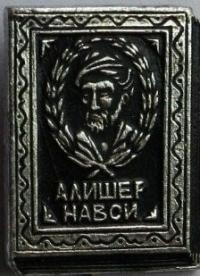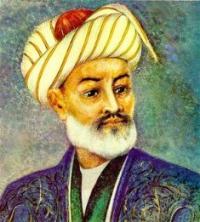You are here
Navoi Alisher.


Travels tours in Uzbekistan.
“I've known rivers:
I've known rivers ancient as the world and older than the flow of human blood in human veins. My soul has grown deep like the rivers”
Langston Hughes.
Great people in the history of Uzbekistan.
Navoi, Alisher Navoi Nizamaddin Mir Alisher (9.2.1441, Herat, - 3.1.1501, ibid.), Uzbek poet, thinker and statesman. Born in the family of Timurid official Giyasaddin Kichkin, whose house was the center of communication between artists, including poets.
Already by the age of 15, N. became known as a poet composing verses in two languages (Central Asian Türks and Farsi). He studied in Herat, Mashhad and Samarkand. In 1469 he became the keeper of the press under the ruler of Khorasan Sultan-Hussein Baykar, with whom he studied at the madrasa.
In 1472 he was appointed vizier and received the title of emir. Navoi assisted scientists, artists, musicians, poets, calligraphers, supervised the construction of madrasas, hospitals, bridges. A convinced humanist, a fighter against medieval despotism and arbitrariness, Navoi denounced the abuse of nobles, the greed of bribe-takers, defended the people before the sultan and decided cases in favor of the unjustly offended.
Progressive positions of N. caused dissatisfaction at the court. In 1487, Navoi was exiled to the remote province of Astrabad as ruler. The collapse of hopes for the possibility of political reorganization of the country and the establishment of peace in a state torn apart by the Timurid strife forced Navoi to leave the service.
Returning to Herat in 1488, Navoi spent the end of his life in intensive creative work. The literary heritage of N. is great and multifaceted: about 30 collections of poems, major poems, prose works and scientific treatises that comprehensively reveal the spiritual life of Central Asia in the 15th century.
Navoi creatively used the centuries-old artistic experience of the literature of the peoples of Central Asia and the Middle East. "Treasury of thoughts" - a collection of poems collected and arranged by the poet himself in 1498 - 1499.
Chronographically in four collections-sofas, respectively, the four steps of the poet's age: “The curiosities of childhood”, “The rarities of youth”, “The curiosities of middle age”, “Edification of old age”. This collection includes poems of various lyrical genres, gazelles are especially numerous (more than 2,600), N.'s favorite genre, distinguished by surprising integrity.
The poet also left "Divan Fani" - a collection of poems in Farsi. The pinnacle of Navoi’s work is the famous “Pyateritsa”, the theme of which was prompted by Jami: “Confusion of the righteous” (1483), “Leyli and Mejnun” (1484), “Farhad and Shirin” (written in 1484), “Seven Planets ”(1484),“ Iskandarov Wall ”(1485).
In accordance with the stable Eastern tradition, “Pyateritsa” N. was the “answer” (nazir) to “Pyateritsa” by Nizami Ganjavi and the Indo-Iranian poet Amir Khosrov Dekhlevi, who wrote in Farsi. Referring to the plots of their works, having perceived some formal features, N. gave a completely different ideological and artistic interpretation of the subject and plot situations, a new interpretation of images and events. “
The confusion of the righteous,” the first poem of the cycle, consists of 64 chapters and is of a philosophical and publicistic character, highlighting the most essential questions of the then reality; in the poem feudal feuds and cruelty of nobles, arbitrariness of the Beks, hypocrisy and hypocrisy of Muslim sheikhs and lawyers are sharply exposed, the ideals of justice are asserted.
The poem presents the main features of N.'s worldview, his ethical and aesthetic views. “Leyli and Mejnun” is a poetic development of the popular ancient Arabian legend about the tragic love of the young Kais to the beautiful Leyli.
Humanistic pathos, emotional tension of the conflict, the power of artistic influence on the reader were the cause of the enormous influence of the poem on many oriental literatures and Uzbek folklore. “Farhad and Shirin” is a heroic and romantic poem about the love of the bogatyr Farhad to the Armenian beauty Shirin, claimed by the Iranian shah Khosrov.
The poem differs from previous works that developed this plot in that it is not Shah Khosrow who becomes her central image, but Farhad, a fighter for truth and justice, whose heroic acts are contrasted with the cowardice of the Shah.
The image of Farhad has become a household name, embodying the socio-aesthetic ideal of the people. N. used the techniques of folk poetics, traditions of the national heroic epos. “Seven Planets”, the fourth poem of the cycle, consists of seven fabulous stories, united by a common frame.
The poem contains allegorical hints criticizing the real environment of Navoi, the rulers - Timurid, Sultan-Hussein himself, his courtiers, and others. “Iskandar Wall” is the final poem of the cycle, its hero is the ideal just ruler, high-moral sage Iskandar.
The book "The Quarter of the Distracted" (1492) is dedicated to Jami. For studying the history of Uzbek and Persian-Tajik literature and their interrelations, the anthology “Collection of the Subtlest” (1491 - 1492) was significant: brief characteristics of the writers of the N. era, “History of Iranian kings” and “History of the prophets and wise men” information about the legendary and historical figures of Central Asia and Iran, the Zoroastrian and Koranic mythology. Important questions of the theory of literature, especially versification, are covered in the treatise
“The scales of sizes”. At the end of his life, N. wrote an allegorical poem "The Language of Birds" (1499) and a philosophical and didactic essay "Beloved of Hearts" (1500) - about the best structure of human society. A well-known influence on the book of Navoi was the works of Yusuf Balasaguni and Gulistan by Saadi.
The main idea of the book is the condemnation of “cruel, ignorant and depraved kings”, the desire to establish a strong centralized power of a just ruler at the head of a prosperous country. This was the dream of the poet's life.
Tragically aware of the impossibility of realizing his political ideals, he nevertheless believed in the ultimate victory of the bright beginning. Hence the optimism and life-affirming power of his creations. In the literature of that time it was believed that the language of the Turks is rude for poetry; N. in the treatise
"The dispute of two languages" (1499) theoretically substantiated the cultural and artistic significance of the old Uzbek language, called the Turks. N. has influenced the development of not only Uzbek literature, but also the development of Uygur, Turkmen, Azeri, Turkish, Tatar and other Turkic literatures. N.'s worldview and creativity is not without ideological contradictions, social illusions.
But the pathos of creativity N. in his humanism and democratic aspirations, in the approval of the dignity of man, his right to happiness. Creativity N. was of great importance for the development in the oriental literatures progressive-romantic creative method.
The bright figure of N., the artistic power of his poetry aroused great interest among Orientalists. There was a special area of scientific research - navoyovedenie. The works of Russian and Soviet scientists are known: V. V. Barthold, E. E. Bertels, A. Sharafutdinov, Aybek, V. Zakhidov, I. Sultanov, A. N. Boldyreva, A. A. Semenov, A. Yu. Yakubovsky , H. Suleiman, A. Khaitmetov, A. Abdugafurov, P. Shamsiev and others. Much work is being done in the Uzbek SSR to prepare scientific and popular publications of N. His poems have been translated into many languages.
Manuscripts N. stored in the largest libraries in the world.
Enlightener:
Khurshid Davron Library. http://greylib.align.ru
Cit .: Asarlar, vol. 1‒15, Tashkent, 1963‒1968; in Russian per. - Poems and poems, M., 1965; Vol., T. 1‒10, Tash., 1968‒70. Literature: Bertels E.E., Navoi. Experience of creative biography, M. - L., 1948; his same FAV works Navoi and Jami, M., 1965; Boldyrev A.N., Persian translations of “Madzhalis an-Nafais” by Navoi, “Scientific Notes of Leningrad State University”, 1952, sir. 128, c. 3; Zakhidov V., The World of Ideas and Images of Alisher Navoi, Tash., 1961; Khayitmetov A., The creative method of Navoi, Tash., 1965; Abdugafurov A., Navoi Satirasi, Whale. 1‒2, Toshkent, 1966‒72; Sulton I., Navoiining Kalb Daftari, Tashkent, 1969; Svidina E.D., Alisher Navoi. Bibliography (1917 – 1966), Tash., 1968.







